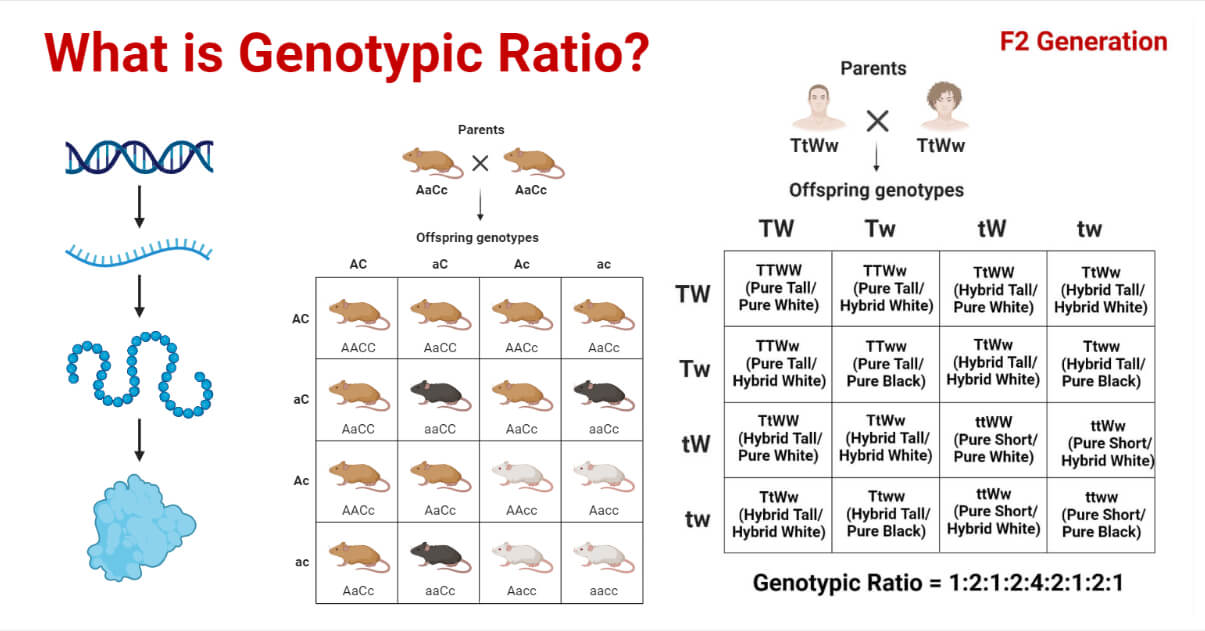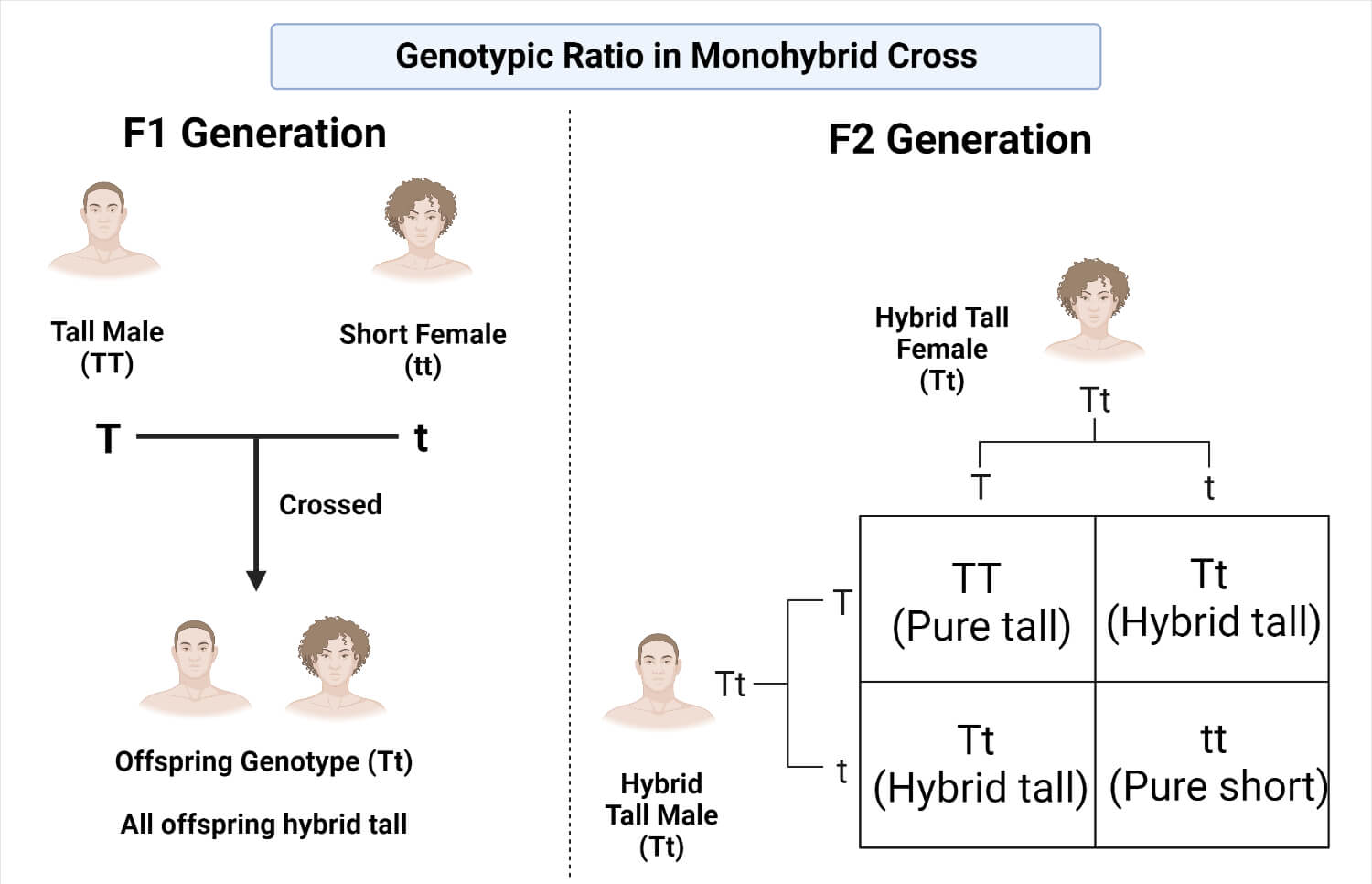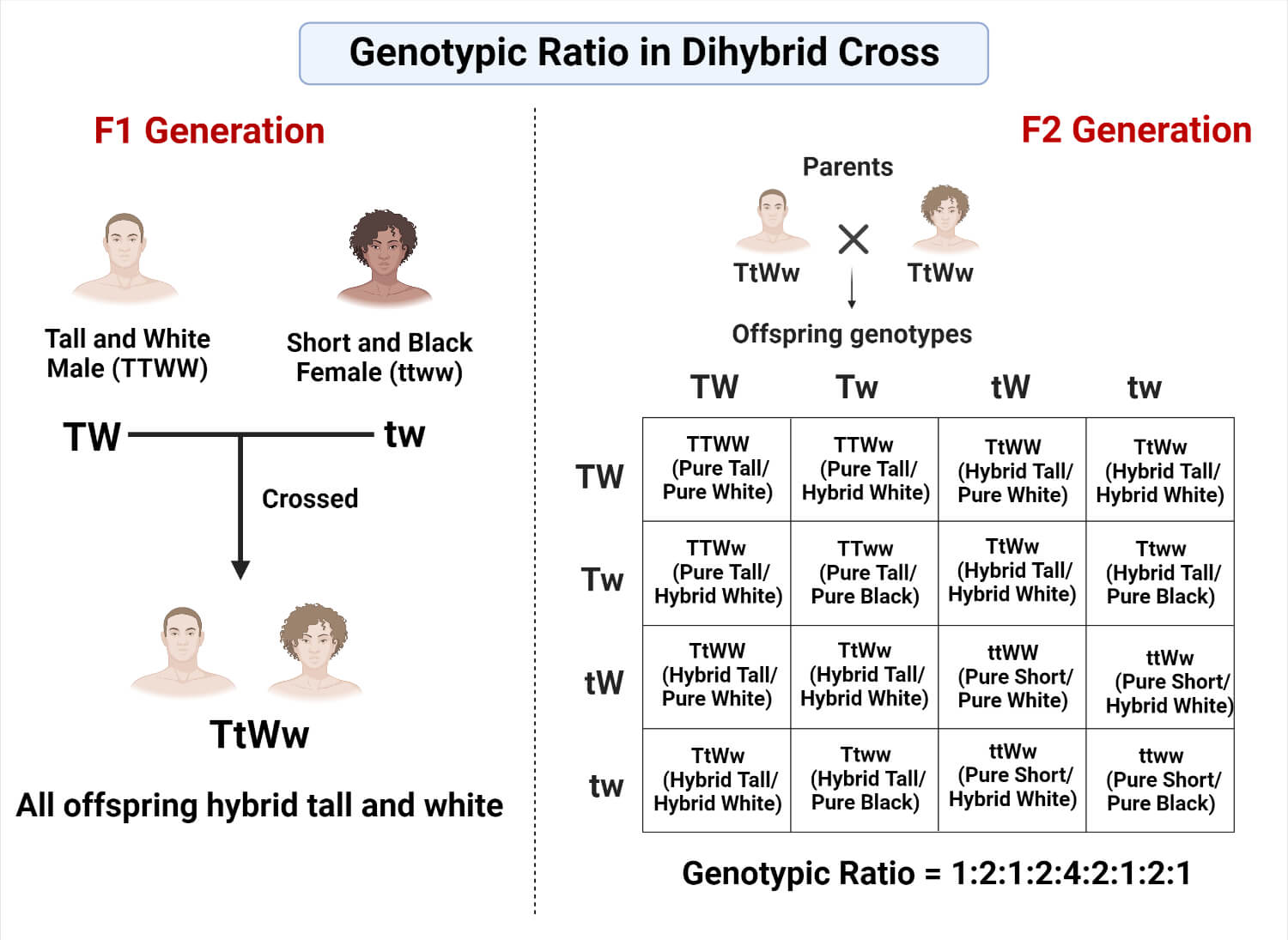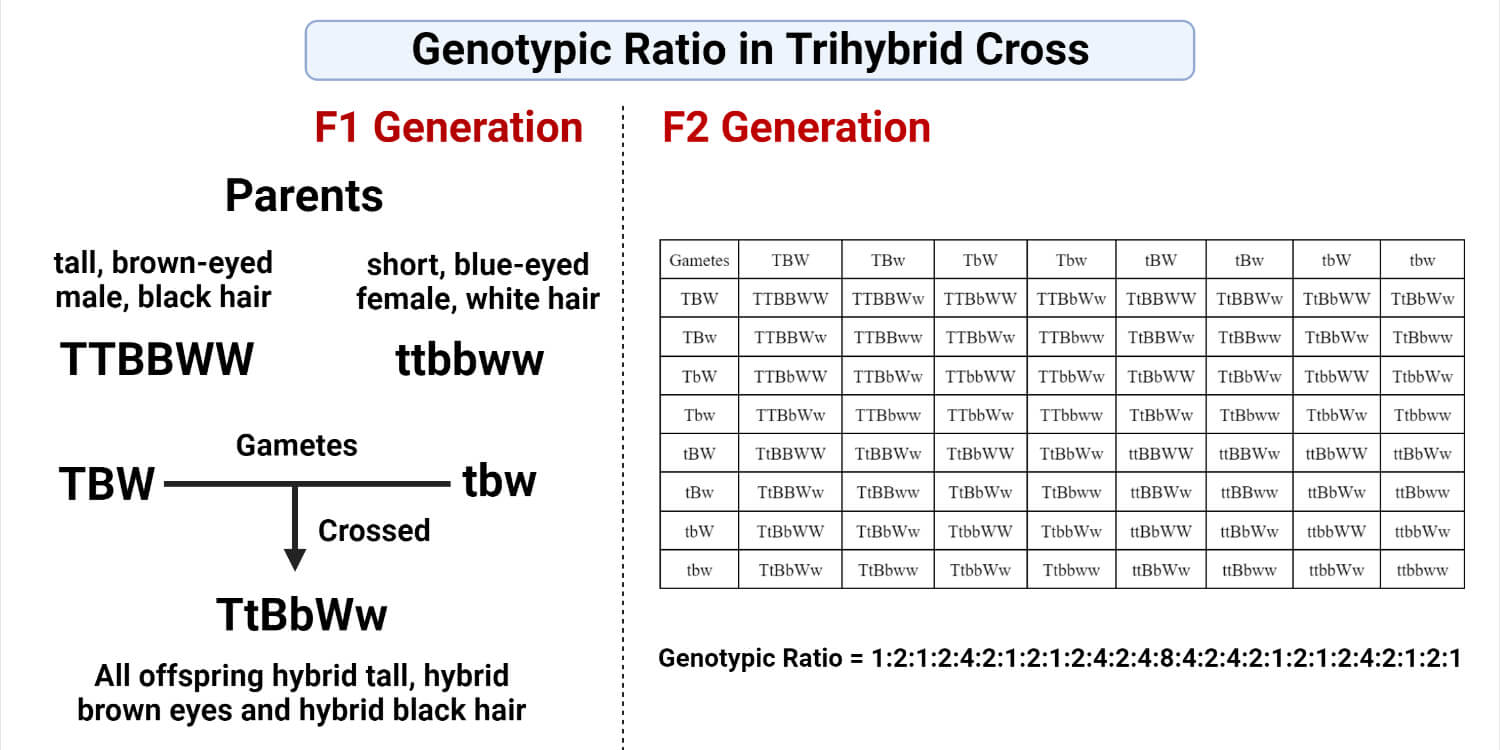The genotypic ratio is the depiction of the ratio of the resulting patterns and frequencies of inherited genes after crossing in the offspring of organisms. In simple language, it is the ratio of the composition of genes in the progenies of an organism.
Genotype is the genetic constitution or expression of an organism. In simple language, the genotype is the type or combination of different genes in an organism resulting in some external appearance.

Genes of an organism can be expressed (dominant) or remain suppressed without expression (recessive). The expressed genes result in the phenotypic characteristics of an organism. The particular phenotype can also have different genotypes. For eg., Tt and TT are different genotypes but express the same phenotype of tallness.
Interesting Science Videos
Calculation of Genotypic Ratio
The calculation of the ratio of genotypes for monohybrid, dihybrid, and trihybrid crosses is different. The basic steps of calculation are:
- Choosing the characters to be crossed or the characters under study.
- By applying Mendel’s Laws of Inheritance, cross them by forming a cross diagram or Punnett-square chart.
- Then calculate the number of specific genotypes (not be confused with the phenotype). The tallness can be denoted by TT and Tt and they both are different genotypes where one is pure and homozygous whereas the other is hybrid and heterozygous respectively.
- The type of genotypic outcomes must be listed distinctly and the ratio can be finally determined by adjusting the characters along with their specific numbers (as counted in the Punnett chart) respectively. Genotypes can be looked at diagonally in the Punnett chart which would make the counting easier.
Genotypic Ratio in Monohybrid Cross
It is the type of cross in which a single trait of an individual is taken and studied for its outcomes after the cross. Let’s take, for example, height: a homozygous tall father (TT) who is crossed with a mother with short height (tt) where tallness is dominant over shortness, then the genotypic-ratio can be calculated as follows:

The genotypes in the second filial generation are:
- Pure Tall (With homozygous allele (TT)) – 1
- Hybrid Tall (With heterozygous allele (Tt)) – 2
- Pure Dwarf/ Short (With homozygous allele (tt)) – 1
So the genotypic ratio will be 1:2:1, respectively. It simply indicates that if four offspring are born in the above case, then there is a higher probability of only one of them being pure tall, although two of them will be phenotypically tall.
Genotypic Ratio in Dihybrid Cross
It is the type of cross in which two characters or traits are taken into consideration and the combined outcomes of both are calculated. Let’s take, for example, height and color: a tall and white colored male (TTWW) who is crossed with a short and black female (ttww) (considering tallness and white skin are dominant over shortness and black skin), then the cross-ratio can be calculated as follows:

The genotypes in the second filial generation are tall and white.
- One pure tall and pure white (Homozygous alleles: TTWW)
- Two pure tall and hybrid white (TTWw)
- One pure tall and pure black (TTww)
- Two hybrid tall and pure white (TtWW)
- Four hybrid tall and hybrid white (TtWw)
- Two hybrid tall and pure black (Ttww)
- One pure short and pure white (ttWW)
- Two pure short and hybrid white (ttWw)
- One pure short and pure black (ttww)
So the genotypic ratio will be 1:2:1:2:4:2:1:2:1, respectively, considering the above data and assumptions. It simply indicates that if 16 offspring are born in the above case, then there is a higher probability that only one of them will be pure tall and white and only one pure short and black, all others will be hybrid.
Genotypic Ratio in Trihybrid Cross
It is the type of cross in which three characters are taken and studied for their combined outcomes in future generations. Let’s take, for example, height, eye, and hair color: a tall, brown-eyed male with black hair (indicated by TTBBWW respectively) who is crossed with a short and blue-eyed female with white hair (ttbbww) (considering tallness (T), brown eye (B), and black hair (W) color are dominant over shortness (t), blue eye (b), and white hair (w) color), then the genotypic-ratio can be calculated as follows:

The genotypes in the second filial generation are a total of 27 in number, and they are:
- One pure tall, brown-eyed, and black-haired individual (TTBBWW)
- Two pure tall and brown-eyed but hybrid black-hair (TTBBWw)
- One pure tall, brown-eyed, and pure white-haired (TTBBww)
- Two pure tall, hybrid brown-eyed, and pure black-haired (TTBbWW)
- Four pure tall, and hybrid brown-eyed & black-haired (TTBbWw)
- Two pure tall, hybrid brown-eyed, and pure white-haired (TTBbww)
- One pure tall, blue-eyed, and black-haired (TTbbWW)
- Two pure tall, blue-eyed, and hybrid black-haired (TTbbWw)
- One pure tall, blue-eyed, and white-haired (TTbbww)
- Two hybrid tall, pure brown-eyed, and black-haired (TtBBWW)
- Four hybrid tall, pure brown-eyed, and hybrid black-haired (TtBBWw)
- Two hybrid tall, pure brown-eyed and white-haired (TtBBww)
- Four hybrid tall, brown-eyed, and black-haired (TtBbWW)
- Eight hybrid tall, brown-eyed, and black-haired (TtBbWw)
- Four hybrid tall, brown-eyed, and pure white-haired (TtBbww)
- Two hybrid tall, pure blue-eyed, and black-haired (TtbbWW)
- Four hybrid tall, pure blue-eyed, and hybrid black-haired (TtbbWw)
- Two pure short, brown-eyed, and hybrid black-haired (ttBBWw)
- One pure short, brown-eyed, and black-haired (ttBBWW)
- Two pure short, hybrid brown-eyed, and pure black-haired (ttBbWW)
- One pure short, brown-eyed, and white-haired (ttBBww)
- Two hybrid tall, pure blue-eyed, and white-haired (Ttbbww)
- Four pure short, hybrid brown-eyed, and black-haired (ttBbWw)
- Two pure short, hybrid brown-eyed, and pure white-haired (ttBbww)
- One pure short, blue-eyed, and black-haired (ttbbWW)
- Two pure short, blue-eyed, and hybrid black-haired (ttbbWw)
- One pure short, blue-eyed, and white-haired individual (ttbbww)
So the genotypic ratio will be 1:2:1:2:4:2:1:2:1:2:4:2:4:8:4:2:4:2:1:2:1:2:4:2:1:2:1 respectively, based on the above data and assumptions.
Genotypic Ratio Significances
- Genetic combinations are necessary to be studied to identify the alterations in genes in each generation.
- The calculation of the genotypic ratio helps us to predict the likelihood or chances of the presence of particular genes in future generations.
- These calculations aid in the production of genetically engineered products as desired.
Important Terms related to Genotypic Ratio
Pure Line: It includes those organisms that have arisen through self-fertilization repeatedly, and remain homozygous for a specific trait. This trait is transferred to offspring when mated to a true breeding organism.
Homozygous: It is the condition in which the individual carries two identical alleles for a specific trait. For eg., TT is known as a homozygous or pure allele indicating tallness.
Heterozygous: When the alleles for a particular trait are different, it is called heterozygous. For eg., Tt is heterozygous as both alleles are different.
Filial generation: The offspring or progenies obtained after the cross between parents are called filial generation or first filial generation (F1 generation). When those progenies self-fertilize and result in another generation of progenies then they are the second filial generation (F2 generation).
Punnett square: It is an illustration of all the possible combinations of phenotypes in the offspring after crossing the specific traits of parents. It is represented in the form of a square-shaped table. R.C. Punnett invented it in the year 1906. In this table, all the possible gametes from the male are arranged in the top horizontal boxes, and all the gametes from the female are arranged in the left vertical boxes.
Note: All the above given genotypic ratios are based on Mendel’s laws of inheritance, where the mutation is not considered. All the characters in parents are based on homozygous alleles. The dominant allele is written in capital and at first whereas the recessive one is written in small. Recessive characters are expressed only in homozygous condition. The formula used for the calculation of no. of genotypes is 3n where n is the number of genes. For eg. In the trihybrid cross, no. of genes = 3, hence no. of genotypes = 33 = 27.
References
- Keshari A.K. and Ghimire K.R. (2010) Mendel’s Laws of Inheritance. Vidyarthi Pustak Bhandar. 4th ed. pg. 618-640.
- Genotypic Ratio. Accessed from: https://biologydictionary.net/genotypic-ratio/ Accessed on: 11/28/2022
- Ahluwalia, K.B. (2009) Genetics. 2nd ed. New Delhi. New Age International.
- Klug W.S. (2015). Concepts of Genetics. 11th ed. BostonLachance, Joseph. “A fundamental relationship between genotype frequencies and fitnesses.” Genetics vol. 180,2 (2008): 1087-93.
